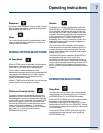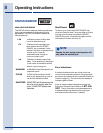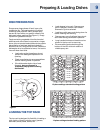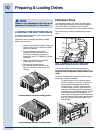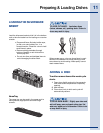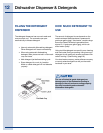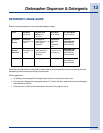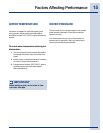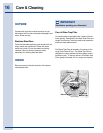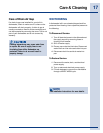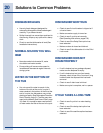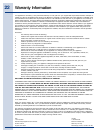
20
Solutions to Common Problems
DISHWASHER LEAKS
• Use only fresh detergent designed for
automatic dishwashers. Measure detergent
carefully. Try a different brand.
• Spilled rinse aid can cause foam and lead to
overflowing. Wipe up any spills with a damp
cloth.
• Check to see that dishwasher is level (See
Installation Instructions).
NORMAL SOUNDS YOU WILL
HEAR
• Normal sounds include water fill, water
circulation and motor sounds.
• Pump pulsing will cause motor speed to
increase and decrease at regular intervals
during cycles.
WATER IN THE BOTTOM OF
THE TUB
• It is not normal for water to remain in the
bottom of the tub at the end of a cycle. If
water remains in the bottom of the tub at the
end of a cycle, the dishwasher may not be
draining properly. (See Dishwasher Does Not
Drain Properly, page 21.) The filter may also
need to be cleaned. (See Care of Filter, page
16.) Note: It is normal to see a small amount
of water under the filter at the end of a cycle.
DISHWASHER WON’T RUN
• Check to see if circuit breaker is tripped or if
a fuse is blown.
• Make sure water supply is turned on.
• Check to see if cycle is set correctly.
(See Operating Instructions, pages 5-8.)
• Check to see if the Delay Start option has
been selected.
• Make sure door is closed and latched.
DISHWASHER DOES NOT
DRAIN PROPERLY
• If unit is hooked up to a garbage disposal,
make sure the disposer is empty.
• If unit is hooked up to a new food waste
disposer, check to see if the “knockout” plug
located inside the disposal inlet has been
removed.
• Check to see if drain hose is kinked.
• Make sure cycle is complete, not in a pause.
CYCLE TAKES A LONG TIME
• Check to see if cycle is in a water heating
delay.
• Check to see if the delay start option has
been selected.
• Check to see if the sanitize option has been
selected.
• Check to see if the dishwasher is in the Child
Lock mode.



